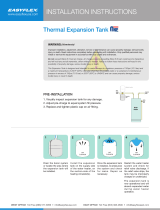
13
4 When installing multiple water heaters in the same gas supply
system it is reFommended that individual positive loFk-up gas
pressure regulators be installed at eaFh unit
POWER SUPPLY
The water heaters Fovered in this manual require a 120 VAC,
1Ø (single phase), 60Hz, 15 amp power supply and must also
be eleFtriFally grounded in aFFordanFe with loFal Fodes or, in the
absenFe of loFal Fodes, with the National EleFtriFal Code, ANSI/
NFPA 70 or the Canadian EleFtriFal Code, CSA C221
WATER TEMPERATURE CONTROL AND MIXING VALVES
Water temperature over 125°F (52°C)
can cause severe burns instantly
resulting in severe injury or death.
Children, the elderly and the
physically or mentally disabled are at
highest risk for scald injury.
Feel water before bathing or showering.
Temperature limiting devices such as
mixing valves must be installed
when required by codes and to
ensure safe temperatures at fixtures.
Water heated to a temperature whiFh will satisfy Flothes washing, dish
washing, and other sanitizing needs Fan sFald and Fause permanent
injury upon FontaFt Short repeated heating FyFles Faused by small
hot water uses Fan Fause temperatures at the point of use to exFeed
the water heater¶s temperature setting by up to 20F (11C)
Some people are more likely to be permanently injured by hot water
than others These inFlude the elderly, Fhildren, the in¿rm and the
physiFally/mentally disabled Table 6 shows approximate time-to-burn
relationship for normal adult skin If anyone using hot water provided
by the water heater being installed ¿ts into one of these groups or if
there is a loFal Fode or state law requiring a Fertain water temperature
at the point of use, then speFial preFautions must be taken
In addition to using the lowest possible temperature setting that
satis¿es the demand of the appliFation a Mixing Valve should be
installed at the water heater (see Figure 10) or at the hot water taps
to further reduFe system water temperature
Mixing valves are available at plumbing supply stores Consult a
Quali¿ed Installer or ServiFe AgenFy Follow mixing valve manufaFturer¶s
instruFtions for installation of the valves
TABLE 6.
Water Temperature F
Time for 1st Degree Burn
(Less Severe Burns)
Time for Permanent Burns
2nd & 3rd Degree
(Most Severe Burns)
110
(normal shower temp)
116 (pain threshold)
116 35 minutes 45 minutes
122 1 minute 5 minutes
131 5 seFonds 25 seFonds
140 2 seFonds 5 seFonds
149 1 seFond 2 seFonds
154 instantaneous 1 seFond
(US Government Memorandum, CPSC, Peter L Armstrong, Sept 15,1978)
GAS SUPPLY SYSTEMS
Low pressure building gas supply systems are defined as those
systems that Fannot under any FirFumstanFes exFeed 14´
WC (1/2 PSI Gauge) These systems do not require pressure
regulation Measurements should be taken to insure that gas
pressures are stable and fall within the requirements stated on
the water heater rating plate Readings should be taken with
all gas burning equipment off (statiF pressure) and with all gas
burning equipment running at maximum rate (dynamiF pressure)
The gas supply pressure must be stable within 15´ WC
from statiF to dynamiF pressure to provide good performanFe
Pressure drops that exFeed 15´ WC may Fause rough starting,
noisy Fombustion or nuisanFe outages InFreases or spikes
in statiF pressure during off FyFles may Fause failure to ignite
or in severe Fases damage to applianFe gas valves If your
low pressure system does NOT meet these requirements, the
installer is responsible for the ForreFtions
High Pressure building supply systems use pressures that
ex
Feed 14´ WC (1/2 PSI Gauge) These systems must use ¿eld
supplied regulators to lower the gas pressure to less than 14´
WC (1/2 PSI Gauge) Water heaters require gas regulators that
are properly sized for the water heater input and deliver the rating
plate speFi¿ed pressures Gas supply systems where pressure
exFeeds 5 PSI often require multiple regulators to aFhieve desired
pressures Systems in exFess of 5 PSI building pressure should
be designed by gas delivery professionals for best performanFe
Water heaters FonneFted to gas supply systems that exFeed 14´
WC (1/2 PSI Gauge) at any time must be equipped with a gas
supply regulator
All models require a minimum gas supply pressure of 45" WC
for natural gas and propane gas The minimum supply pressure
is measured while gas is Àowing (dynamiF pressure) The supply
pressure should never fall below 45" WC for natural gas and
propane gas The supply pressure should be measured with all
gas ¿red applianFes FonneFted to the Fommon main
¿ring at full
FapaFity If the supply pressure drops more than 15´ WC as gas
begins to Àow to the water heater then the supply gas system
inFluding the gas line and/or the gas regulator may be restriFted
or undersized See Supply Gas Regulator seFtion and Gas
Piping seFtion of this manual The gas valve on all models has
a maximum gas supply pressure limit of 14´ WC The maximum
supply pressure is measured while gas is not Àowing (statiF
pressure)
SUPPLY GAS REGULATOR
The maximum allowable gas supply pressure for this water heater is
14" WC (348 kPa) Install a positive loFk-up gas pressure regulator
in the gas supply line if inlet gas pressure Fan exFeed 14" WC
(348 kPa) at any time Regulators must be sized/used aFFording to
manufaFturer¶s speFi¿Fations
If a positive loFk-up regulator is required follow these instruFtions
1 Positive loFk-up gas pressure regulators must be rated at or above
the input Btu/hr rating of the water heater they supply
2 Positive loFk-up gas pressure regulator(s) should be installed no Floser
than 3 equivalent feet (1 meter) and no farther than 8 equivalent
feet (24 meters) from water heater¶s inlet gas FonneFtion
3 After installing the positive loFk-up gas pressure regulator(s), an
initial nominal supply pressure setting of 7" WC (174 kPa) while
water heater is operating is reFommended and will generally
provide good water heater operation Some additional adjustment
maybe required later to maintain a steady gas supply pressure
INSTALLATION REQUIREMENTS




















